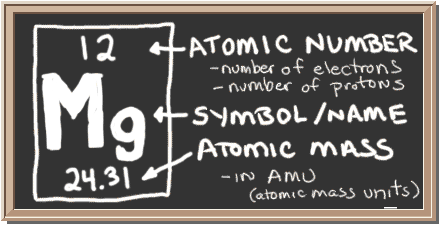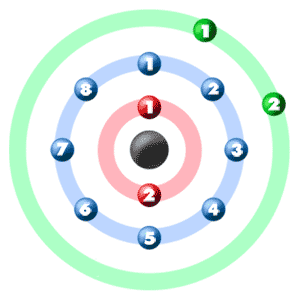
Check out the blackboard. That box on the left has all of the information you need to know about one element. It tells you the mass of one atom, how many pieces are inside, and where it should be placed on the periodic table.
In the next section we're going to cover electron orbitals or electron shells. This may be a new topic to some of you.
Electrons In The Shells
Take a look at the picture below. Each of those colored balls is an electron. In an atom, the electrons spin around the center, also called the nucleus. The electrons like to be in separate shells/orbitals. Shell number one can only hold 2 electrons, shell two can hold 8, and for the first eighteen elements shell three can hold a maximum of eight electrons. As you learn about elements with more than eighteen electrons you will find that shell three can hold more than eight. Once one shell is full, the next electron that is added has to move to the next shell.So... for the element of MAGNESIUM, you already know that the atomic number tells you the number of electrons. That means there are 12 electrons in a magnesium atom. Looking at the picture, you can see there are two electrons in shell one, eight in shell two, and two more in shell three.


Examples of Compounds with Magnesium
Magnesium OxideMagnesium (Mg) is able to bond with one oxygen (O) atom. The formula of the compound is MgO. You can see in the dot structure that the two atoms share four different electrons. When a bond is made with four electrons, it is called a double bond. It is stronger than a single bond which only uses two electrons. |
|
|
|
|
||
Magnesium DichlorideMagnesium dichloride is commonly known as magnesium chloride. You can use either name when talking about the compound. Since magnesium (Mg) has two extra electrons it looks around for elements which could use them. In this case, magnesium bonds with two chlorine (Cl) atoms which each need one electron. With the additional electron, chlorine has a filled shell and magnesium loses two electrons. Magnesium also has a filled shell! |
|
|




